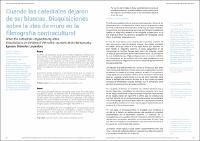Please use this identifier to cite or link to this item:
https://repositorio.usj.es/handle/123456789/886
| Title: | Cuando las catedrales dejaron de ser blancas. Disquisiciones sobre la idea de muro en la filmografía contracultural |
| Other Titles: | When the cathedrals stopped being white. Disquisitions on the idea of the wall in countercultural filmography |
| Authors: | Grávalos Lacambra, Ignacio

|
| Keywords: | Camp; Muro; Psicodelia; Counterculture; Wall; Psychedelia; Cinema |
| Issue Date: | 23-Dec-2022 |
| Citation: | Grávalos Lacambra, I. (2022). Cuando las catedrales dejaron de ser blancas: Disquisiciones sobre la idea de muro en la filmografía contracultural. VAD. Veredes, Arquitectura Y divulgación, (8), 22–34. Recuperado a partir de https://veredes.es/vad/index.php/vad/article/view/cuando-las-catedrales-dejaron-de-ser-blancas-disquisiciones |
| Abstract: | El cambio de paradigma cultural que se estaba fraguando a finales de los años sesenta, va a contraponer dos modos diversos de entender la idea del muro, uno heredado de la ortodoxia moderna y otro desarrollado por la contracultura. Esa oscilación, de la esencia a la apariencia, coincidirá con la crisis del movimiento moderno. Es en este contexto en el que surge la propuesta contracultural norteamericana como reacción estética, que dotará a los espacios de una nueva sensualización, alterando la idea del límite. El presente artículo indaga en la iconografía fílmica que se produjo en torno a la descomposición del muro y, en consecuencia, del espacio. En ella se refleja la metamorfosis en la concepción superficial del cerramiento a través de procesos de textilización, biomorfización y disolución. |
| Description: | The cultural paradigm shift that was taking shape at the end of the 1960s was going to oppose two different ways of understanding the idea of the wall, one inherited from modern orthodoxy and the other developed by the counterculture. This oscillation, from essence to appearance, will coincide with the crisis of the modern movement. It is in this context that the North American countercultural proposal emerges as an aesthetic reaction, which will give spaces a new sensuality, altering the idea of the limit. This article investigates the filmic iconography that was produced around the decomposition of the wall and, consequently, of space. It reflects the metamorphosis in the superficial conception of the enclosure through processes of textileization, biomorphization and dissolution. |
| URI: | https://repositorio.usj.es/handle/123456789/886 |
| ISSN: | 2659-9198 |
| Appears in Collections: | Artículos de revistas |
Files in This Item:
| File | Description | Size | Format | |
|---|---|---|---|---|
| Cuándo las catedrales dejaron de ser blancas.pdf | 609,22 kB | Adobe PDF |  View/Open |
This item is licensed under a Creative Commons License

